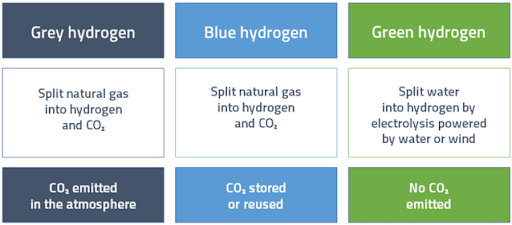Governance
Towards A Zero Carbon Future
This article is based upon Green hydrogen, a new ally for a zero carbon future which was published in The Hindu on 09/09/2021. It talks about the need for alternative sources of energy and the significance of Green Hydrogen in “Zero Carbon dioxide Emissions”.
The quest for discovering alternatives to fossil fuels, responsible for the production of over 830 MT per annum of carbon dioxide, has been going on for years.
The latest studies by scientists have signalled the crucial issue of climate vulnerability, especially for the Asian countries. The forthcoming 26th UN Climate Change Conference of the Parties (COP26) in Glasgow will re-examine the climate adaptation measures and coordinated action plans to mitigate the impact of greenhouse gases.
In the light of finding an alternative source for powering India’s industries and lighting its homes with zero emissions of CO2, Green Hydrogen is a compelling option to rely on.
Green Hydrogen
- Hydrogen and Green Hydrogen: It is the most abundant element on the planet having energy density almost three times that of diesel, but present rarely in its pure form.
- Hydrogen is designated with different colours depending upon its production technique; Black hydrogen is produced by use of fossil fuel, whereas Pink hydrogen is produced through electrolysis, but using energy from nuclear power sources.
- Green hydrogen is a zero-carbon fuel produced from electrolysis using renewable energy (wind or solar) to split water into hydrogen and oxygen.
- Need for Green Hydrogen: Generation of power via natural resources like Green hydrogen will be a major step forward in achieving the target of ‘net zero’ emissions.
- As per the International Energy Agency (IEA), India is the world’s fourth largest energy consuming country after China, USA and EU and will overtake the EU to become the third largest energy consumer by 2030.
- For a country with such a high level of energy consumption, shifting to a renewable source of energy becomes even more important considering the present climate vulnerabilities.
- As per the International Energy Agency (IEA), India is the world’s fourth largest energy consuming country after China, USA and EU and will overtake the EU to become the third largest energy consumer by 2030.
- Initiatives Taken for Adopting Green Hydrogen:
- The Indian Railways have recently announced the country’s first experiment of a hydrogen-fuel cell technology-based train by retrofitting an existing diesel engine.
- The Union Budget (2021-22) has announced a National Hydrogen Energy Mission (NHM) for using hydrogen as an energy source.
- Saudi Arabia is also prioritising plans to manufacture renewable energy by utilising ‘idle-land-banks’ for solar and wind energy generation.
- It is working to establish a mega $5 billion green hydrogen manufacturing unit covering a land-size as large as that of Belgium, in the northern-western part of the country.
- In the Asia-Pacific sub-continent, Japan and South Korea are on the front foot in terms of hydrogen policy making.
- Japan’s Basic Hydrogen Strategy sets out the country’s action plan till 2030, including the establishment of an international supply chain.
- The Indian Railways have recently announced the country’s first experiment of a hydrogen-fuel cell technology-based train by retrofitting an existing diesel engine.
Issues Associated
- An Expensive Source: The production cost of green hydrogen has been considered to be a prime obstacle.
- According to the International Renewable Energy Agency (IREA), the production cost of this ‘green source of energy’ is expected to be around $1.5 per kilogram (for nations having perpetual sunshine and vast unused land), by the year 2030.
- Large Investments Required: The commercial usage of hydrogen as a fuel and in industries requires mammoth investment in R&D of such technology and infrastructure for production, storage, transportation and demand creation for hydrogen.
- Availability of Electrolysers: The shortage of electrolysers (a device which splits water to form H2 and O2 using electricity) can become a roadblock for meeting the estimated requirement on green hydrogen.
- The cost of electrolysers has the highest share in the total production cost of green hydrogen.
- Manufacturing capacity of such electrolysers may require investments between Rs 15,000-20,000 crore.
Way Forward
- Decentralised Production: Decentralised hydrogen production must be promoted through open access of renewable power to an electrolyser.
- There shall be mechanisms to ensure access to round-the-clock renewable power supply for decentralised hydrogen production.
- Wheeling Electricity: It is a more viable option than transportation of hydrogen by trucks.
- For instance, wheeling electricity from a solar plant in Kutch to a refinery in Vadodara could lower the transportation cost by 60%, compared to delivering hydrogen using trucks.
- Blending Hydrogen: Blending a certain percentage of green hydrogen with grey hydrogen for existing applications like oil refining and fertilizers, depending on the viability gap.
- Mandating new greenfield capacities of hydrogen applications like oil refining and fertilizers to use only green hydrogen from a future cut-off date (to avoid long term lock-ins).
- Regional Cooperation: India should form a regional alliance with countries South Korea, Japan and Singapore to export green hydrogen from coastal India to help them reach their net-zero ambitions.
Conclusion
Power generation by green hydrogen will be a viable solution to achieve the target of ‘net-zero’ emission to remain under 1.5° C. It will also be a leap forward in minimising the dependence on conventional fossil fuels.
It is high time to catch up with the rest of the world by going in for clean energy, decarbonising the economy and adopting ‘Green hydrogen’ as an environment-friendly and safe fuel for the next generations.
|
Drishti Mains Question Green hydrogen as an alternative source of energy can be the long-sought solution of the problem of global warming and GHG emissions. Discuss. |





